Living Light in the Ocean
Dr. Edith A. Widder
Harbor Branch Oceanographic Institution
Seeing the light
There are living lights in the ocean. Some flash. Some glow. Others pulsate, whirl and shimmer. These lights are not just fascinating from a scientific perspective. They are also beautiful, hypnotic, sometimes puzzling and often downright breathtaking. None of the pictures I will show you here do justice to the phenomenon. But at least they provide a glimpse of this most incredible and least known of animal behaviors.
What are living lights?
Bioluminescence is visible light made by living creatures. On land it is rare. Fireflies are the best-known terrestrial living lights, but there are a few others, such as earthworms, centipedes, and fungi. However, these creatures are generally not found in high abundance and do not play a significant role in the balance of nature on land. By contrast, in the ocean bioluminescence is very, very common.
Light emitters in the ocean come in an astonishing variety of forms ranging from microns (Figure 1) to meters (Figure 2), from autotrophs (Figure 3) to herbivores (Figure 4) to carnivores (Figure 5), from brainy red heads (Figure 6) to dumb blonds (Figure 7), and from elegant (Figure 8 ) to bizarre (Figure 9).
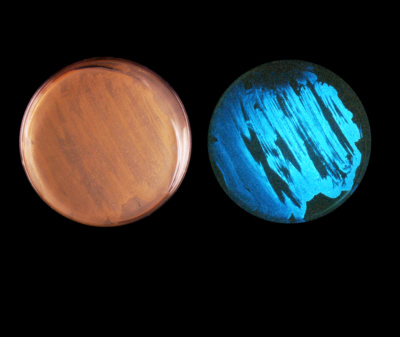
Figure 1 – Bioluminescent bacteria. Photo credit: Edith A. Widder Harbor Branch Oceanographic Institution
Figure 2 – http://news.bbc.co.uk/1/hi/sci/tech/2910849.stmThe colossal squid, Mesonychoteuthis hamiltoni, has bioluminescent light organs under each eye. This recently found specimen is not yet full grown but is 16 feet long and 330 pounds.
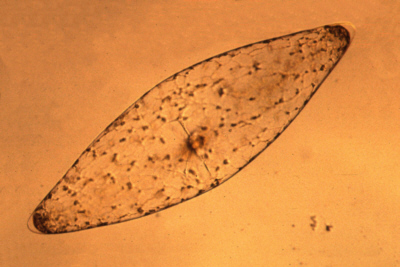
Figure 3(A) - The bioluminescent dinoflagellate, Pyrocystis fusiformis, emits light from cellular organelles, called scintillons. Photo credit: Edith A. Widder Harbor Branch Oceanographic Institution
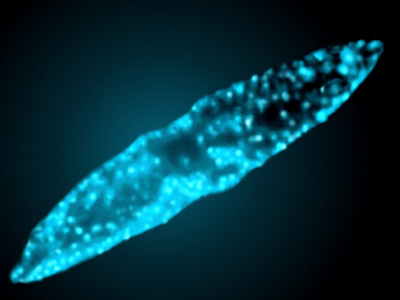
Figure 3(B) - The bioluminescent dinoflagellate, Pyrocystis fusiformis, emits light from cellular organelles, called scintillons. Photo credit: Edith A. Widder Harbor Branch Oceanographic Institution
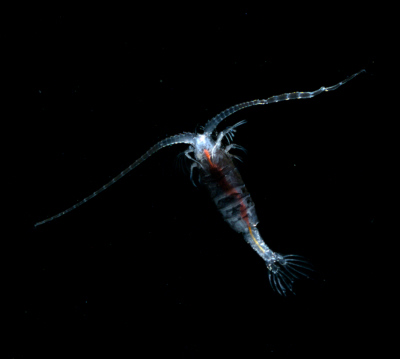
Figure 4 - The bioluminescent copepod, Gaussia princeps, releases bioluminescence into the water from glands on its tail. Photo credit: Edith A. Widder Harbor Branch Oceanographic Institution.
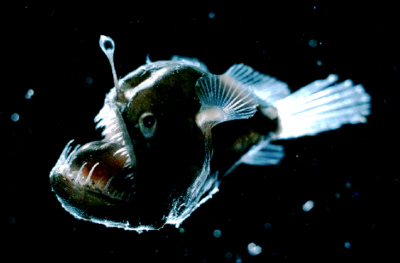
Figure 5 – The blackdevil anglerfish, Melanocetus johnsonii, has a bioluminescent esca that is used to attract prey. Photo credit: Edith A. Widder Harbor Branch Oceanographic Institution.
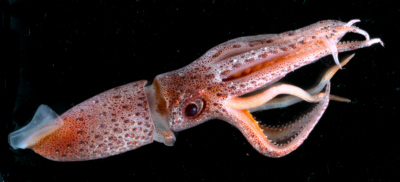
Figure 6 – The bioluminescent squid, Histioteuthis sp. is studded with bioluminescent light organs called photophores. Photo credit: Edith A. Widder Harbor Branch Oceanographic Institution.
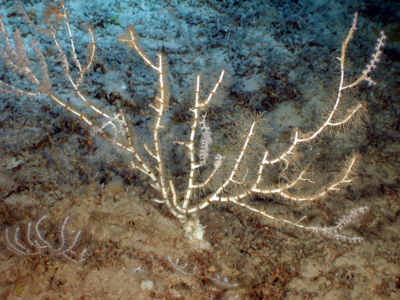
Figure 7(A) – The yellow bamboo coral, Ceratoisis flexibili, emits light when bumped. Photo credit: Edith A. Widder Harbor Branch Oceanographic Institution.
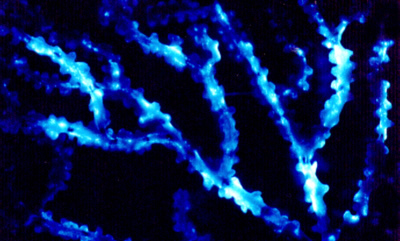
Figure 7(B) – The yellow bamboo coral, Ceratoisis flexibili, emits light when bumped. Photo credit: Edith A. Widder Harbor Branch Oceanographic Institution.
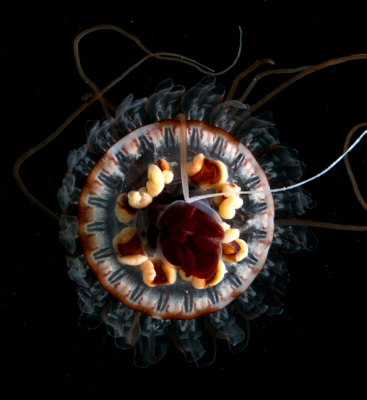
Figure 8(A)– The deep-sea jellyfish, Atolla vanhoeffeni, produces a spectacular display that looks like a pinwheel. Photo credit: Edith A. Widder Harbor Branch Oceanographic Institution.
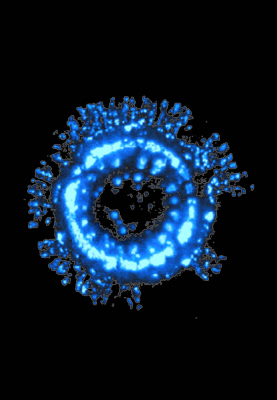
Figure 8(B)– The deep-sea jellyfish, Atolla vanhoeffeni, produces a spectacular display that looks like a pinwheel. Photo credit: Edith A. Widder Harbor Branch Oceanographic Institution.
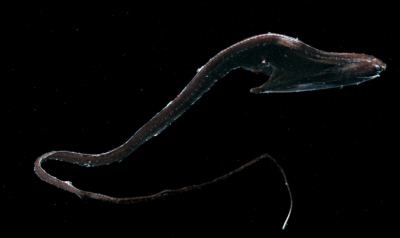
Figure 9 – The gulper eel, Eurypharynx pelecanoides, has a light organ on the end of its tail and luminescent racing stripes that run the full length of its body. Photo credit: Edith A. Widder Harbor Branch Oceanographic Institution.
But even more important than their diversity, is their exceptional abundance. It has been said that there are light producing creatures in virtually every cubic meter of the ocean, from surface to bottom and from coast to coast. Because the oceans represent such a vast amount of living space, this means that the actual numbers involved are staggering.
Living, as most of us do, on dry land, it is easy to forget that Earth is an ocean planet. If we look at an equal area projection of the world we can see that almost three quarters of the planet’s surface is covered by water.
That begins to put things into perspective. But now factor in that the oceans are deep, on average about 4000 meters deep. Then compare that to the living space on land, roughly estimated as extending 50 meters into the tallest trees. When you do that you will discover that the oceans represent more than 99% of our biosphere, the volume inhabited by animals.
In this incomprehensibly vast living space, bioluminescence is the rule not the exception. As a result, light producers may be viewed as some of the most successful species on our planet. For example, did you know that the most abundant vertebrate on our planet is a bioluminescent fish called the Benttooth Bristlemouth (Fig. 11)?
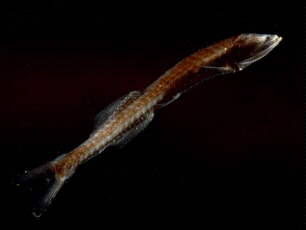
Figure 11 – The benttooth bristlemouth, Cyclothone sp. is the most common vertebrate on our planet. Photo credit: Edith A. Widder Harbor Branch Oceanographic Institution.
Or that, krill, the tiny shrimp-like invertebrates consumed by baleen whales, are bioluminescent (Fig. 12)?
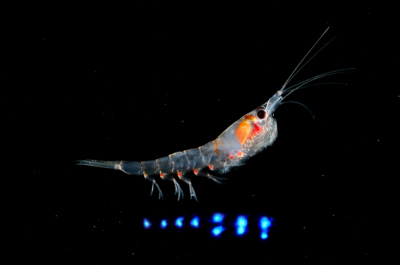
Figure 12 - The euphausiid (krill), Meganyctiphanes norvegica, produces light from ventral, downward directed photophores, that it uses for camouflage. Photo credit: Edith A. Widder Harbor Branch Oceanographic Institution
Or that many of the dinoflagellates that form red tides are also bioluminescent?
Activity #1 (Excerpted from The Bioluminescence Coloring Book, Second Edition by E. A. Widder. Additional information on how to maintain these cultures indefinitely in the lab and experiments that can be done with them are also available from this source.)
Bioluminescence is a great way to excite scientific curiosity in young minds and demonstrations of living light are not difficult. It is easy to grow bioluminescent dinoflagellates. You can order them from Sunnyside Sea Farms, 475 Kellogg Way, Goleta, CA 93117-3804 (Tel 805-964-3755, e-mail: [email protected]). The first 50 ml bag is $6.00 and the price drops the more bags you purchase. These dinoflagellates have the scientific name Pyrocystis fusiformis, which literally means spindle-shaped (fusiform) fire (Pyro) cell (cystis). You will need to expose them to normal room light for at least 8 to 12 hours every day, since these cells need to photosynthesize in order to live and make their bioluminescent chemicals.
Although they are usually only bioluminescent during the night, you can fool them by having the lights on during the night and keeping them in the dark during the day. Then, if you take them out and shake the bag, you will see them flash. The easiest way to control the light/dark cycle is to put the cells under fluorescent lights controlled by a timer. Be careful not to let the cultures get too warm. They grow best at about 20° C (68° F). You can use a small fan blowing over the cultures to help keep them cool while the lights are on. If the cells are maintained at the right temperature and with enough light each day, they will survive in their sealed plastic bags for months.
How do living organisms make light?
All light is the result of the same process. An electron is excited to a higher energy state. When it falls back down to a lower energy level it gives up energy as a photon, the basic unit of light (Figure 13).
Figure 13 Diagram of atom emitting photon http://www.chabotspace.org/vsc/exhibits/solarb/opticslab/lightandoptics/whatmakeslight.asp
The primary difference between different kinds of light is how the electron gets excited in the first place. In incandescence such as from the sun, a candle flame or a light bulb, the electrons are excited by heat, so we tend to associate heat and light. But there are other, more efficient ways of getting electrons excited. One of these is chemiluminescence, where light results from an efficient (also called cold) chemical reaction. Light sticks are an example of a chemiluminescent reaction (Figure 14).
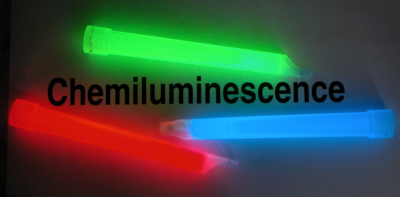
Figure 14 - Light sticks are an example of chemiluminescence. Bioluminescence is another form of chemiluminescent but the chemicals in light sticks are not related to those produced by animals. Photo credit: Edith A. Widder Harbor Branch Oceanographic Institution.
Bioluminescence is a form of chemiluminescence, where the reaction chemicals are produced by living organisms. The names assigned to these chemicals are luciferin for the substrate and luciferase for the enzyme. However, there are many different forms of these chemicals (Figure 15).
The enzymes are proteins assembled out of long chains of amino acids. The luciferins are much smaller molecules. For example jellyfish luciferin, which is also known as coelenterazine, is assembled out of 3 amino acids. Firefly luciferin is derived from just two amino acids (tyrosine and cysteine). Bioluminescent bacteria use a reduced riboflavin phosphate (FMNH2) and dinoflagellates use a tetrapyrol, which is related to chlorophyll.
The generalized equation for a bioluminescent reaction is:
The enzymes are proteins assembled out of long chains of amino acids. The luciferins are much smaller molecules. For example jellyfish luciferin, which is also known as coelenterazine, is assembled out of 3 amino acids. Firefly luciferin is derived from just two amino acids (tyrosine and cysteine). Bioluminescent bacteria use a reduced riboflavin phosphate (FMNH2) and dinoflagellates use a tetrapyrol, which is related to chlorophyll.
The generalized equation for a bioluminescent reaction is:
Luciferase
(catalyst)
Luciferin + O2 ——————> Product* ——————–> Product + Light
(excited state) (ground state)
The key points to note here is that the enzyme, luciferase, catalyzes the reaction of the substrate, luciferin in the presence of oxygen to produce an excited energy state molecule. Then, when the excited state returns to the ground state, photons are released. The need for oxygen is one of the few universals in this equation, otherwise these are all very different chemicals.
Added to all this chemical diversity is the astonishing variety of ways that organisms have evolved to control the light. Once you break a light stick and initiate the light-producing chemical reaction you can’t stop it (go back to Fig. 14).
But animals have to be able to turn the light off as easily as they turn it on. One way to accomplish this is to hold back some very small, but very necessary component of the chemical reaction, such as an ion – a charged atom. A bioluminescent flash is triggered when floodgates in the cell’s membranes are stretched open by a mechanical tap or bump, thereby triggering an action potential – a propagated electrical disturbance. The ions rush in triggering the flash and then the ions are actively pumped out again. The critical ion in many jellyfish is calcium, while in dinoflagellates its hydrogen (see Activities #3 below).
Instead of producing their own chemicals some animals, such as flashlight fish and anglerfish, maintain a symbiotic relationship with bioluminescent bacteria. The fish provide the bacteria with perfect little growth chambers, like the light organ under the eye of the flashlight fish or the lure, called the esca, of the anglerfish (Figure 16).
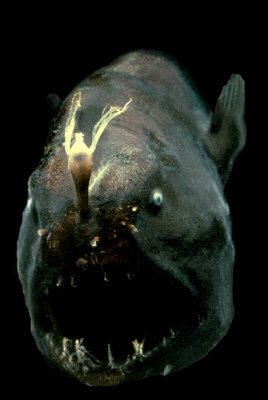
Figure 16 The anglerfish, Oneirodes sp. Photo credit: Edith A. Widder Harbor Branch Oceanographic Institution.
In return for this largesse the bacteria provide the fish with light. However, bioluminescent bacteria are unusual because they produce light all the time and the fish need to be able to turn their lights off when a large predator comes near. To accomplish this, the flashlight fish has evolved an eyelid that closes up over its bacterial light organ like a shutter. In this short video clip of flashlight fish the apparent flashing of their lights is simply due to the rapid opening and closing of this shutter.
(There is no sound on the video clips in this keynote)
Short video clip of flashlight fish
Video clip #1: The apparent flashing of these flashlight fish, Anomalops katoptron, is accomplished by means of a shutter that covers the bioluminescence light organ, which glows all the time. Photo credit: Edith A. Widder Harbor Branch Oceanographic Institution. Filmed at the Stephen Birch Aquarium-Museum (With special thanks to Dr. Margo Haywood and Deeanne Edwards).
Some anglerfish have something like a shutter at the tip of their escas but in many cases the manner in which these fish control their bacterial lights is unknown.
Activity #2 (Excerpted from The Bioluminescence Coloring Book, Second Edition by E. A. Widder) Bioluminescence is cold light, which means that very little energy is wasted as heat. You can demonstrate this principle with lightsticks purchased from a dive shop or a safety supply catalog such as Lab Safety Supply (Tel. 800-356-0783). Lightsticks come in blue, green, red, orange, yellow and white and cost about $2 each. Just as with bioluminescence, different chemicals produce different colors. When you bend and shake the lightsticks, mixing the chemicals inside, you make light the way living organisms do and you can feel that there is no heat coming from the lightstick.
Compare this with a light bulb or a candle flame, where much of the energy associated with the light production is lost as heat. The amount of light that is produced by the lightstick depends on how often the light producing chemicals bump into each other. Just like bumper cars, where the number of collisions depends on the number of bumper cars and how fast they’re all moving, the amount of light produced depends on the number of light producing chemicals and how fast those chemicals are moving. The warmer the chemicals, the faster they move. You can slow down the collision frequency by placing a lightstick in the freezer. Demonstrate what effect this has on the light intensity by breaking two lightsticks of the same type at the same time and placing one of them in a freezer, while leaving the other at room temperature.
After a couple of hours compare the intensity of light from the lightstick in the freezer to the one kept at room temperature. The one kept in the freezer is dimmer, because its chemicals are moving more slowly and not colliding as often. Allow the lightstick from the freezer to warm to room temperature. Now, when you compare, you will find that the lightstick from the freezer is the brighter one. This is because, while it was cold it was using up its light producing chemicals more slowly than the lightstick kept at room temperature. As a result, the stick from the freezer now has more chemicals and more collisions due to different concentrations of the reacting chemicals, rather than to their different speeds.
Activity #3 If you have bioluminescent dinoflagellates you can demonstrate the control of their bioluminescence by hydrogen ions. Place some of the culture in a test tube and add a drop or two of 10% acetic acid or if you don’t have any laboratory acids try vinegar. What happens? Can you get any more bioluminescence out of the cells after they have been chemically stimulated?
From : Classroom Exploration of the Ocean, College of Exploration, Virtual Teacher’s workshop May 04, 2003

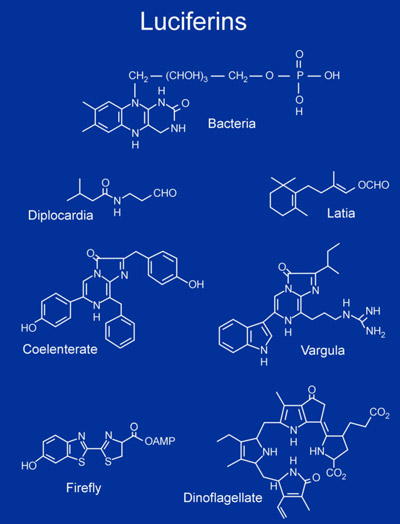
Leave a Reply